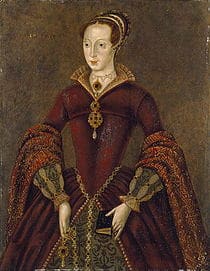 On this day in 1553,1 a triple wedding took place at Durham House, the London residence of John Dudley, Duke of Northumberland. Lady Jane Grey married Guildford Dudley, one of the Duke’s sons, her sister Lady Katherine Grey married Lord Henry Herbert, son of the Earl of Pembroke, and Guildford’s sister, twelve year-old Lady Catherine Dudley, married Lord Henry Hastings.
On this day in 1553,1 a triple wedding took place at Durham House, the London residence of John Dudley, Duke of Northumberland. Lady Jane Grey married Guildford Dudley, one of the Duke’s sons, her sister Lady Katherine Grey married Lord Henry Herbert, son of the Earl of Pembroke, and Guildford’s sister, twelve year-old Lady Catherine Dudley, married Lord Henry Hastings.
Historian Leanda de Lisle describes how all three of the young couples were dressed in silver and gold, “fabrics forfeited to the King from the Duke of Somerset in 1551 and, figuratively at least, marked with his blood”.2 King Edward VI was too ill to attend the marriage, and was in fact dying, but it was an “extravagant spectacle” attended by most of the English nobility and celebrated with jousting, feasting and masques.
Although John Dudley is often thought to have masterminded Lady Jane Grey’s marriage to his son, Guildford, in order to further his control of the country on the death of Edward VI, Leanda de Lisle points out that the marriage was, according to William Cecil, the brainwave of Elizabeth Brooke, second wife of William Parr, Marquis of Northampton.3 Christine Hartweg, wrote in an online article that Dudley and Henry Grey, Jane’s father, were second cousins once removed and “more importantly, they were also good friends, and Henry Grey owed both his place on the Privy Council and his dukedom to John Dudley. Thus, a match between their children was not unlikely or inappropriate.”4
There does not seem to be anything suspicious or underhanded in this marriage match. We can argue until we’re blue in the face about whether this marriage was “a plot to snatch the Crown from its rightful heirs”, or an example of “routine actions of dynastic politics”, but there is no evidence either way.5 Nobody was to know on that May Day in 1553, that the bride and groom only had less than nine months of marriage and life ahead of them.
Notes and Sources
Image: The Streatham Portrait, said to be of Lady Jane Grey.
Extract from On This Day in Tudor History by Claire Ridgway.
- Leanda de Lisle says “The date is almost always given as the 21st but this is drawn from Commendone writing after the event. It was booked to take place on a Thursday (see Albert Feuillerat, Documents Relating to the Revels at Court, p306) and when I calculated the day from other known dates – e.g. Jane’s entry to the Tower – it confirmed my suspicion that it was the 25th.”, p328 in Notes of The Sisters Who Would be Queen, Leanda de Lisle, UK hardback
- Leanda de Lisle, p102 of UK hardback in Chapter “A Married Woman”.
- Ibid., p98 in Chapter “No Poor Child”.
- “John Dudley the Family Man”, Christine Hartweg, presently unavailable.
- Ibid.